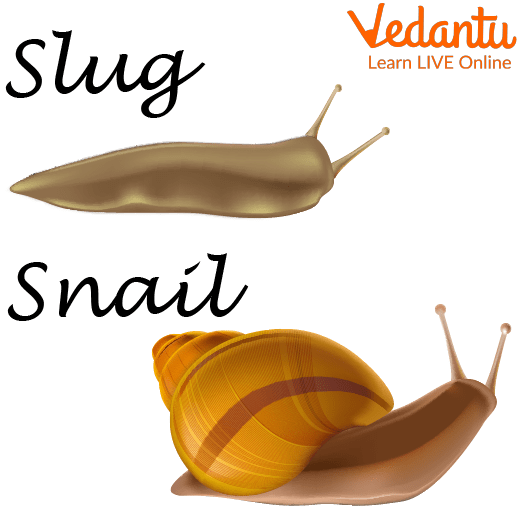




An Introduction to Snail and Slug
Gastropods include both snails and slugs. Slugs are exposed to the weather because they lack the coiled shell that snails have. Snails and slugs differ from one another not just in anatomy but also in habitat, feeding, lifespan, and behaviour. The phylum Mollusca includes the Gastropoda class, which includes the slug and the snail. The term derives from the Greek words gastro (stomach) and podos (feet). Gastropods are often aquatic creatures.

Decaying Leaves
Snails and slugs are often found on dry land. However, both species can occasionally be found in water, even for brief periods. Both creatures leave behind a slime trail. They may move across the ground thanks to mucus. Both types of life can become dangerously dehydrated if they lose moisture to dry soil.
Anatomy of the Slug and Snail
The main distinction between the two species is that the snail has an obvious shell while the slug does not. The snail has a large enough shell for it to duck into for protection. Some snails can retract their shells completely. Slugs lack a defensive shell or mobile house. Slugs commonly employ a vestigial internal shell. Calcium is kept in it for later use. The animal's soft tissue runs the risk of desiccating without a protective shell.
Following are the Difference Between Snail and Slug:
Snail vs Slug: Movement
Snails move around by using a muscular foot called a "foot" that sticks to the ground, while these animals move forward. Slugs lack a muscular foot and they use their body to pull themselves forward on their belly or sides. Slugs go backwards or sideways when needed. But snails cannot do this because the snail's body is covered with a shell and its foot sticks only in one place.
Snail vs Slug: Speed
Different snails and slugs move at various speeds. The average snail can move at a speed of 1 mm/s. It moves more quickly than other slugs. Some snails don't even move at all.
Snail vs Slug: Habitat
Slugs can easily, if slowly, fit into the smallest openings thanks to their lack of a rear shell and the capacity to compress themselves. To their benefit, they make use of loose tree bark, stone slabs, and wooden planks.
Snails immediately retreat to their shells, especially when there are nearby natural predators. Some snails can seal their shells and retract for added defence.

Snail vs Slug
Snail vs Slug: Cuisine
Snails are a delicacy in many nations, but particularly in France. Many upscale restaurants serve cooked land snails as an appetiser called escargot. Large land snails are the major source of the dish's ingredients, largely because they are very nutritious, and it is best to avoid using sea snails because they can be poisonous to people. Slugs may also be eaten.
Summary
Snails and slugs belong to the same class and they both have many similarities like their movement, their food, etc. Snail bodies are covered with a shell that protects them from danger, while slug bodies are not covered with the shell. The shell of snails are much more like an envelope that protects them from predators including humans and can expand when disturbed to increase their size. Snails and slugs both can live in aquatic or terrestrial habitats. They feed by propelling food from the mouth into their intestines where it is digested. Both snails and Slugs are very common and can be found almost everywhere on land and water.
FAQs on Snail Vs Slug
1. Write the main parts of the slug body.
The main parts of the body of the slug are described below.
Tentacles - Two retractable pairs are visual tentacles and sensory olfactory tentacles.
Mantle - The genital opening and anus are in the saddle-shaped mantle behind the head. Breathing openings or pneumo storms occur on the right side of the mantle.
Tail - The part of the body behind the coat.
Kiel - A prominent ridge that runs across the ridge.
Feet - A flat underside that helps the cochlea move through the rhythmic waves of muscle contraction.
Residual Shell - Internalised shell used as a calcium storage shell.
2. Write the similarities between slug and snail.
Snail and slug both belong to gastropod molluscs, both are members of the pulmonates, which is an unofficial group.
In both, the backbone is absent. Both move here and there at a very slow speed. Both move with the help of mucus. They both feed on vegetables and plants. To prevent moisture, both hide in a dark place. Both types of life can become dangerously dehydrated if they lose moisture to dry soil. Slug and snails both eat a variety of organic matter such as leaves, lichens, and fungi.
3. Why are snails and slugs considered agricultural pests?
Slug and snails are agricultural pests as both eat a variety of organic matter such as leaves, lichens, and fungi. They can also cause damage to crops and orchards. Slugs hide beneath leaves and flowers in gardens, where they will eat the plant's roots up to 8 inches below ground level. They sometimes lay eggs on fruit that is off-limits for them, so it can transfer slug infestation to an area with fresh fruit trees or vegetables.
The best treatment for slugs is quick action when detected to prevent them from damaging more of your garden.









